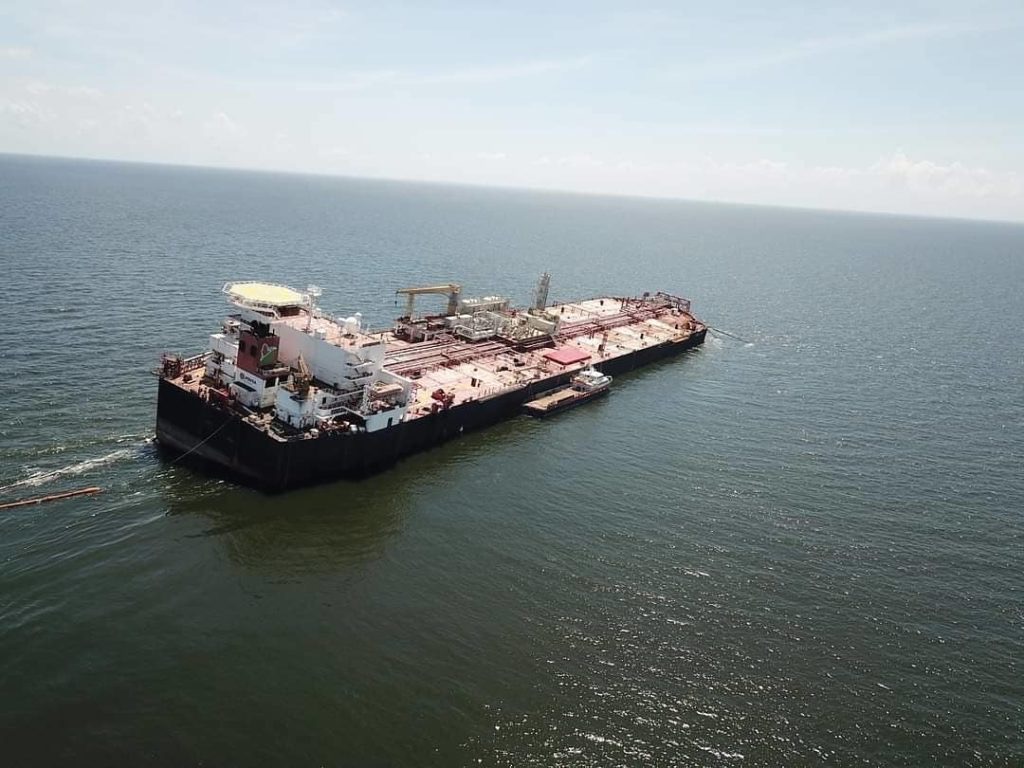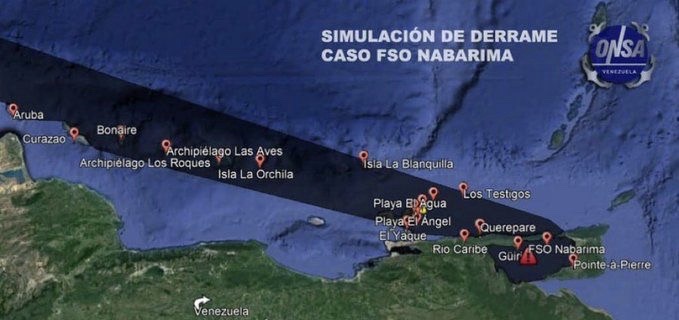Venezuela is on The Brink of its Worst Oil Spill
An FSO loaded with 1.3 million oil barrels, anchored at the Gulf of Paria, could provoke a catastrophe worse than Exxon Valdez’s if is not managed soon


An environmental disaster in the making.
Photo: El Nacional
The Gulf of Paria, located between eastern Venezuela and Trinidad and Tobago, might be close to suffering the worst oil spill in the history of the region: on October 13th, a PDVSA source informed Caracas Chronicles that the Venezuelan floating storage and offloading unit (FSO) Nabarima tilted 5 degrees to its right side and sunk 14.5 meters—right at the waterline—and that water had started to sip into its storage tanks. Nabarima had made a couple of headlines and was atop a social media outcry by activists and conservationists regarding the dangers of its diminished infrastructure during the past month. “It’s scary,” says Eduardo Klein, director of the Remote Sensing and Geo-Spatial Analysis Laboratory of the Department of Environmental Studies at Universidad Simón Bolívar, “there’s no doubt it’d be an environmental disaster.”
FSO Nabarima was built in 2005 by ConocoPhillips to store crude produced from the Corocoro project, a shallow water field in the Gulf of Paria. “It has no motor,” says Klein, “it’s a storage tank in the form of a boat.” The FSO, designed specifically for the area and built in South Korea, is connected to the Corocoro through a 23-kilometer long system of tubes and has been moored there since its first year by eight anchors. Two years after its construction, Hugo Chávez’s government expropriated all of ConocoPhillips’ assets in Venezuela. Nowadays, the Nabarima is owned by Petrosucre, a joint company between the Venezuelan state-owned company PDVSA (owning 74% of the stake) and Italian giant Eni (the remaining 26%).
The Nabarima has been paralyzed since early 2019, after the United States imposed oil sanctions on the Venezuelan regime and Petrosucre stopped selling oil to its main buyer, CITGO. Of the 72 employees it had before sanctions, only three remain, explained Eudis Girot, director of the Unitary Venezuelan Federation of Oil Workers (FUTPV). Since then, the FSO has been storing around 1,300,000 barrels of oil, meaning a Nabarima oil spill would be around five times larger than the 1989 Exxon Valdez disaster in Alaska. Years-long mismanagement and lack of maintenance have made it particularly vulnerable.
According to Girot and NGO Creemos Sucre, activist Juan Gil (who has obtained information and pictures from PDVSA workers who asked to not be identified), the FSO’s electric generator and boiler aren’t working, the fire-fighting system and the alarms are out of service and corrosion covers the structure. In fact, on PDVSA’s webpage, the latest maintenance report from the Nabarima dates from September 2014. Even more importantly, as Girot has informed since August, the FSO is enduring internal meters-high water breaches. This is the reason why the Nabarima is tilting on its side, according to Klein. “These internal floods are happening because of failures in the water pumping system,” says Gil, “not because it’s sinking.”

The tilt is obvious.
Photo: Twitter via CNW
Yet, due to its anchors, Klein considers that the possibilities of the FSO overturning completely are not very high. Its security standards and its locality-customized design also reduce the risk of a spill, says Klein, because even if there hasn’t been proper maintenance, “it has the advantage of being relatively new.” For Klein, however, the threat of PDVSA’s low response capacity to a spill is worrisome: “Seeing the experience we had with the Morrocoy and Río Seco spills, where there wasn’t any response, I wouldn’t expect one in a Nabarima spill.”
The Year of Spills
Maduro’s presidency has been defined by oil spills. According to environmental consultant Flora Barboza, Lake Maracaibo experiences a constant spillage of one to eight barrels a day since 2012. Similarly, the Paraguaná refinery complex (which includes the Amuay; Bajo Grande, and Cardón refineries) in the western state of Falcón has been continuously spilling oil into the sea for years through its industrial waters outlets, says Klein. 2020 has seen a continuous strain of spills since the Pirial de Punta de Mata’s (Monagas) spill in January. These were followed by new spills in Paraguaná, by the Río Seco spill in September (which wasn’t contained for weeks) and by three spills in the El Palito refinery in the state of Carabobo: the first one in late July, the second one in early August, and the third one in mid-October, before the refinery stopped. These last spills have been particularly notorious, as the oil reached parts of the Morrocoy National Park, known for its biodiversity of marine and bird species and its pristine beaches.
Based on satellite images (which are not completely stable due to the changing nature of the oil stains), Klein calculated that the first El Palito spill consisted of 26,000 barrels, covering a maritime surface of 350 kilometers, “a gigantic mantle,” he says, “that could cover Caracas twice and you’d still have some oil left.” In fact, it was almost three times as big as the simultaneous and more media-covered Mauritius spill in Africa. Yet, three months after the disaster, PDVSA still hasn’t admitted the spill happened, also maintaining silence on the spilled barrels calculations: “No one has said anything,” says Klein, “so I assume our calculations were correct.”
The other conservationists and biologists that mobilized to clean the oil (due to PDVSA’s lack of response) in some of Morrocoy’s beaches haven’t been able to measure the impact (especially on submarine floors and ecosystems) because the state hasn’t given access to the oil area to researchers and has ignored their proposals. “There are zones that we know were effectively affected,” says Klein, citing research by the Venezuelan Ecology Society, “but without a monitoring process it’s impossible to know.” While researchers and conservationists didn’t observe bird populations affected by oil, they did observe the oil effects on mangroves, a keystone species in the ecosystem. “The mangrove is losing its leaves,” says Klein, “it’s an evident effect.”
This, Klein explains, “is not an absolute catastrophe,” as it only affected certain parts of the park: “It’s an intermediary effect, fortunately, it wasn’t as bad as it could’ve been.” Yet researchers and conservationists still have to wait until they’re allowed into the area to compare the diagnosis of Agenda Morrocoy (a ten-year-old compilation of environmental research on Morrocoy, which is the most studied ecosystem in Venezuela) with the park’s current state. “The submarine impact cannot be seen through satellite images or on a boat,” says Klein, “one has to go and take samples.”
PDVSA’s almost total lack of response in the Morrocoy emergency, explains Klein, contrasts with how the old PDVSA responded to the Carenero spill of 1998, when 4,000 diesel barrels spilled from the Maritza Sayalero ship near the coastal town of Higuerote. Back then, Klein remembers, the company had a National Contingency Plan for Oil Spills that included contention barriers, absorbent material, specialized staff, warehouses with special equipment, training and simulacrums. “It worked very well,” remembers Klein, who was present in Carenero because PDVSA turned to the scientific community. Together, they protected mangroves with barriers, removed mountains of dead and polluted bivalves and gastropods, closed the beach, and forbade fish consumption.

A simulation of what a spill would actually look like.
Photo: Onsa Venezuela
Paria Under Threat
Klein’s latest model, based on the wind and sea currents of Sunday, October 18th, predicts that if a Nabarima spill were to happen this week, the oil would cover most of the towns and scenic coasts of the Gulf of Paria in Sucre. “The main factor that moves spilled oil is the wind, then the current and the tides,” says Klein. “If current conditions change, the oil would leave the Bocas del Dragón straits and onto Trinidad.”
To predict these patterns, Klein has to rely on models that aren’t completely reliable because “nowadays the formal meteorological network is destroyed, we have no information on the wind,” while “the National Institute of Meteorology and Hydrology (INAMEH) isn’t providing data” from the Güiria weather station in the Gulf of Paria.
“I reached some researches from the Oceanographic Institute of Venezuela in the University of Cumaná,” says Gil, “and they told me that there aren’t any scientific researchers in Paria left because they were evicted by local mafias” such as drug and women traffickers, and groups that extort cacao and rum producers. “Since 2015, the problem intensified,” he says, “There were many clashes between the different gangs that control the area and between the mafias and the government.”
Avoiding Disaster
After the Nabarima started to get traction on social media in early September, following a set of videos of PDVSA workers denouncing the situation in the tanker and calling for a disaster aversion, chavista accounts on social media responded with repetitive tweets denying the FSO’s state and videos of PDVSA workers “debunking the right media scoundrel.” Yet, four days after the first outcry—explained Girot—Eni fixed some of the water pumps and drained the water. A month later, it seems the water is back, considering the Nabarima’s tilt. Seeking to avoid a spill, Eni announced in early September that it was seeking the United States’ authorization to transport the oil from Nabarima to another tanker without being sanctioned. While this should be a routine process for the FSO, as the PDVSA boats would pump the oil out from the floating storage, turning on the pump could be dangerous because “the generators are damaged,” says Gil, based on Girot’s information. The oil stored in the tanker is a blend of heavy and light crude, but after staying still for months, Gil explains, the two components have separated, which could “damage the internal layer of where they are stored.”
International concerns have been raised since Sunday, when the United States embassy in Trinidad and Tobago released a statement saying that the U.S. “strongly supports immediate actions to bring the Nabarima up to international safety standards and avoid possible environmental harm” while specifying that the American sanctions are not designed to “target activities addressing safety, environmental, or humanitarian concerns,” effectively greenlighting Eni. The same day, the Trinidadian Ministry of Foreign Affairs said that despite repeated attempts to view and inspect the Nabarima, they hadn’t been granted permission by Venezuelan authorities, which moved the original permission from late September to October 20th.
On Monday, Reuters reported that two sources said that two PDVSA boats were heading towards the Nabarima to pump the oil out. According to Refinitiv’s Eikon tracking data software, at least two tugboats usually used to offload oil from FSOs were near the Nabarima. The tanker Icaro, from PDVSA’s subsidiary PDV Marina, was also on its way to the Gulf of Paria. One of Reuter’s sources indicated it would also pump the oil out of the Nabarima.
Although there seems to be a chance of averting this crisis, PDVSA’s mismanagement has ridden the industry with such hazards. The Inciarte, for example, a tanker that has been out of service since 2017 and that is being used as floating storage, is another time bomb as it sits in the bay of Pozuelos in similar conditions of abandonment as the FSO, a PDVSA source explained to Caracas Chronicles.
Hopefully, the lush coastal valleys and palms of Paria and Trinidad will be safe from the black waves. Although we will never know for sure, with PDVSA’s lack of transparency—unless the worst comes to pass.
Caracas Chronicles is 100% reader-supported.
We’ve been able to hang on for 22 years in one of the craziest media landscapes in the world. We’ve seen different media outlets in Venezuela (and abroad) closing shop, something we’re looking to avoid at all costs. Your collaboration goes a long way in helping us weather the storm.
Donate




